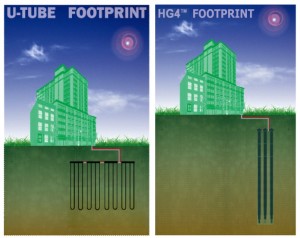Designing Hybrid Renewable Energy Systems for the Future
What is Geothermal?
“Efficient, Effective, Economical, & Enduring Energy”
Of all energy-related technological advances in the past 25 years, geothermal offers the greatest energy cost savings.
What Makes AEG’s Geothermal Offering Different?
AEG Utilizes Geothermal Innovation’s Advanced, Patented Technology
The GI4 Heat Exchanger offers:
AEG offers a complete array of complementary alternative energy and energy conservation technologies that can be installed on a single building or sets of buildings, or initiated system wide

Comparison of U-Bend vs. Gi.4 Foot Print for Similarly Sized Building